One point that was particularly popular in a recent video chat – ‘How can I dress up without a suit?’ – was the idea of an unstructured or shirt jacket, to wear at home.
Something that you can throw on for a video phone call, in other words, but doesn’t feel odd if you continue to wear it around the house. Very relevant during the lockdown recently, and perhaps increasingly so in the future.
One of the issues with such a jacket is that the cloth is absolutely crucial. As there is no structure in the jacket, you’re effectively wearing just cloth. It’s purely pieces of material sewn together in whatever shape and size you desire.
So I thought it would make sense to add a brief chapter to our Guide to Cloth, looking at which materials are most suitable.
The Guide is nearing completion now, having covered every type of cloth from summer trousers to the venetian weave, and we’re filling in a few gaps here and there. Black tie is another one we’ll add soon.
If you read this and the other chapters, and feel there are any more gaps, please do let me know. It’s already the most comprehensive reference source out there, I think, but that doesn’t mean it can’t be better.
The word ‘unstructured’ is used in tailoring to describe a range of makes – from a jacket with no shoulder pad or lining, to something with nothing inside at all. Basically, anything that has less structure than the tailor’s normal make.
Here, we mean the latter, the entirely unstructured. No shoulder pad, no canvas, no lining. Just cloth. It is probably doubled up on the front of the jacket, to form some type of inner layer, but still – cloth is all there is.
The key characteristic this cloth needs, as a result, is body.
It needs to have enough strength and density to hold a line without the support of structure inside. It needs to drape well: something more commonly discussed in womenswear, but crucial in a menswear piece like this.
If the material is too soft, or too loosely woven, it will crumple as soon as it comes under pressure. The inside of the elbow will squash and fold, distorting the sleeve. The skirt at the back will be crushed as soon as you sit down, leaving a concertina following you around.
So, what kind of materials have this body?
Well, it’s an area we have touched on in other chapters. We know that trousers need this body, for example, and it’s a reason a twill weave is so commonly used in trousers.
We also know that soft fibres, such as cashmere, aren’t any good without the support of another fibre in the mix. That’s something an unstructured jacket has in common with both suits and trousers.
And we know that weight will help. Hence our discussion of light and heavy versions of linen (with linen being, perhaps surprisingly, often cooler in a heavier weight – as it flows more and sticks less).
So denser weaves, stronger fibres, and heavier weights.
If we start with the more luxurious, and perhaps more formal, type of jacket, then silk and worsted wool will be the things to watch out for.
A lightweight jacket, perhaps 220-280g, in a worsted wool twill, will look sharp and luxurious yet still hold a good line. If something soft like cashmere is used, then silk is helpful in the mix to add body.
A piece like this, if a tailor can make it, will have the wonderful light feeling of a ‘giacca-camicia’ – a shirt-jacket – with the seams around the shoulders pressed flat and almost invisible. A lovely, cool thing to wear in the summer.
The alternative for an unstructured summer piece is pure linen, perhaps cotton.
This will have less body, and will wrinkle. But it’s a conscious choice we’ve made. We accept the disadvantages because want the cool-to-the-touch feel of linen. Or indeed because we want a different style: a relaxed, rumpled look. The aim is no longer an elegant, clean drape.
Still, if we want to minimise that wrinkling we can. By using a heavier, more densely woven linen: Irish, rather than Italian, in a twill rather than a plain weave, and around 10 or 11oz in weight. The same goes for fine cottons.
The next alternative is a rougher, tougher look: a workwear cotton jacket.
Again, we know that the cotton will not drape well. Cotton just doesn’t. But we can still keep a nice shape by using more robust cottons, most likely in a twill weave.
Some heavier, tougher worsted wools can have a similar feeling as well.
Finally, there are knitted fabrics like jersey.
The advantage here is that they will have natural stretch, so they will feel comfortable in a similar way to a shirt, even if cut closer (the exact opposite of cotton, which usually has no natural stretch).
The downside is drape, and therefore wool is the best fibre to use, and ideally the fabric should be fairly heavy. Otherwise the jacket will look more like a piece of knitwear.
It’s also worth investing in good-quality jersey, as cheaper versions have a tendency to stretch and bag-out over time. That elasticity slowly fades away.
In the end, the key thing about an unstructured jacket is to be clear what look you’re after.
A linen jacket will look and feel very different to a fine wool, and again to a rough cotton. There is no structure, so the cloth choice becomes even more important, and they all create very different looks.
You can even have pure cashmere, and it will feel lovely. It will just look more like a blanket hanging off your shoulders than a tailored jacket.
The method of construction makes a difference too of course. A worsted wool piece might be made more like a jacket; a cotton workwear one will probably be rather different, with lapped seams, patch pockets and no doubling of material on the facings.
Also, it is less likely that a bespoke tailor will be able to make something akin to workwear. For that, you will likely be doing made-to-measure, or made-to-order from a brand using a factory – someone like Stile Latino that made my unstructured jersey jacket above.
But cloth choice is important there as well, even if it’s more directed by the brand. And indeed if you’re choosing between a handful of ready-to-wear jackets.
Jackets pictured, from top, are:
- Dalcuore unstructured jacket on George Wang, Brio
- Ettore de Cesare with an unstructured coat of his
- Interior of Stile Latino jersey jacket of mine
- Close-up of George’s jacket
- Dalcuore unstructured linen jacket
- Close-up and full shot of my Stile Latino jacket
- Stile Latino jacket and coat (below)



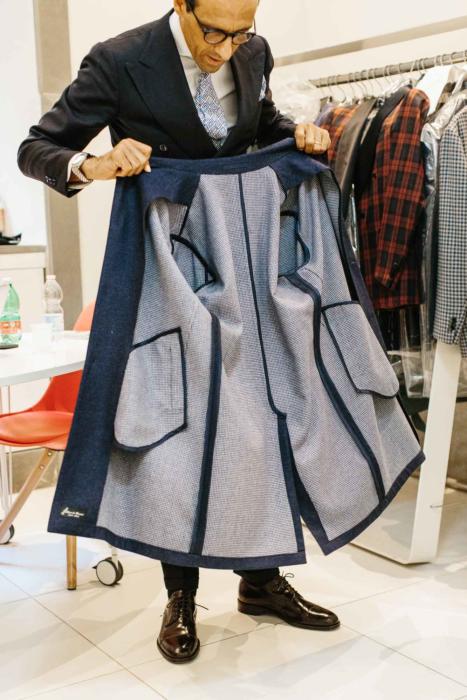
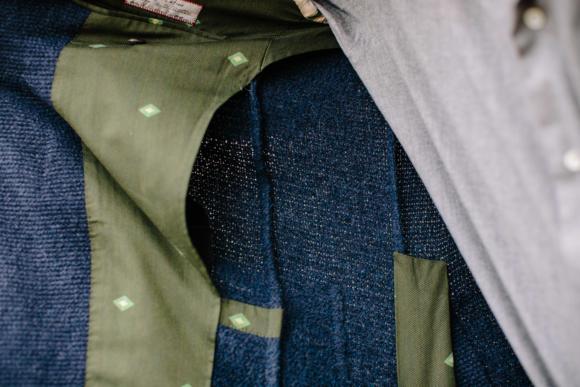
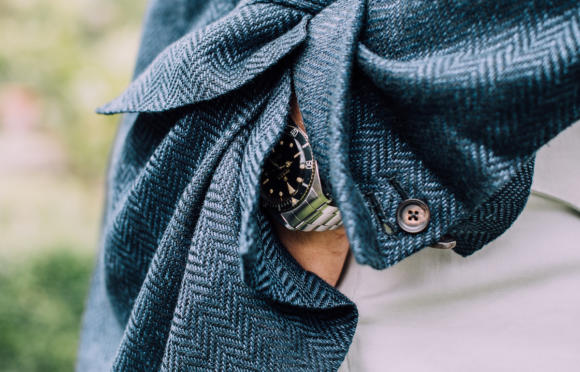
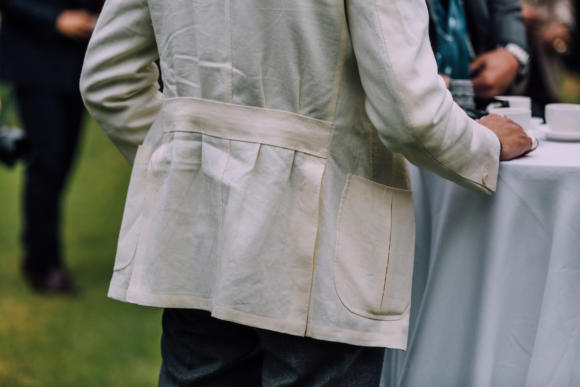
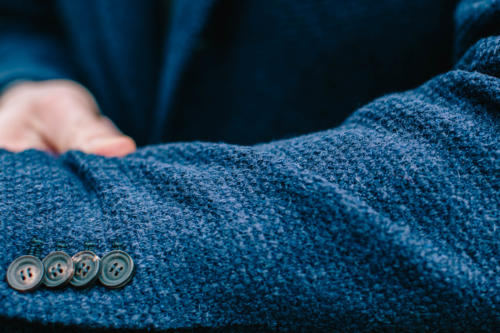
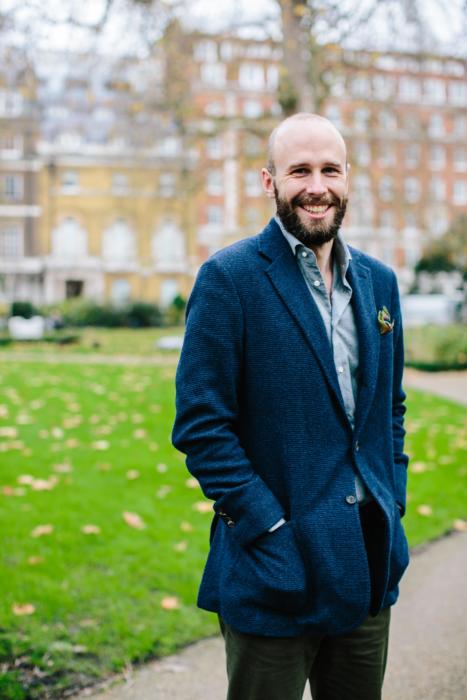
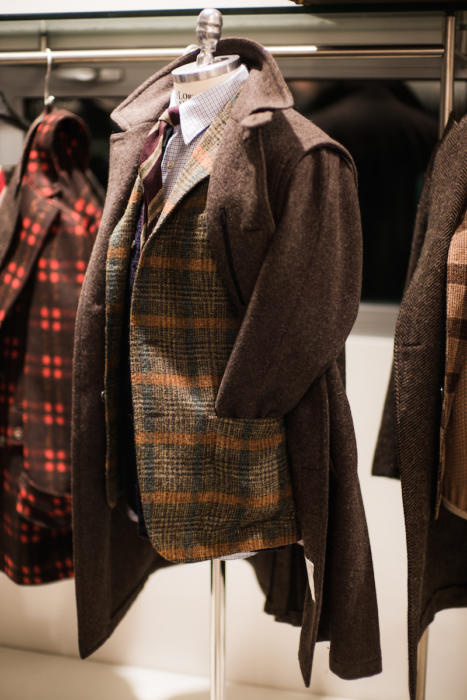
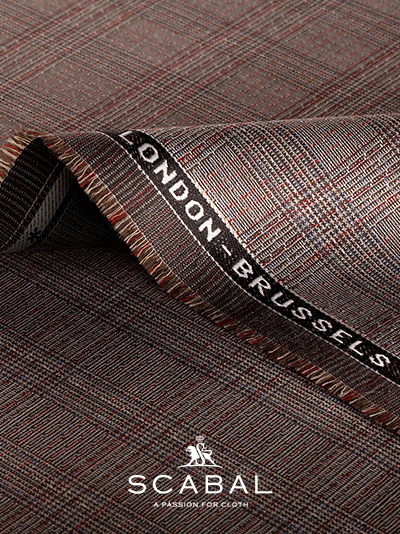
nice vintage Submariner, is that a 5513?
I’ll have to ask the wearer, George
May I ask you to ask George about the lovely cloth this jacket is made of? He seems to have an inclination for unusual blues or related colours like this turquoise, doesn’t he? I’m thinking of his azure shirt in your book “The Style Guide” here. Both times combined with cream or off-white, by the way.
On it Jakob.
And yes, good point on the blues. George experiments with interesting things in general too
Great article as usual Simon, thanks.
I have a somewhat related quandary. I teach in a school and am looking ahead to September, when we anticipate a full return of all students. I would like to continue to wear a (relatively unstructured) jacket for meetings, whole school events, and so on. Given the ongoing pandemic, and the potential for serious outbreaks in educational settings, school management have decided that staff should only wear machine washable clothing, to allow for better infection control.
Are you aware of any jacketings that can be frequently machine washed? And makers producing machine washable jackets?
Hi Benjamin
Good question. No is the short answer, I’ve never looked into it really. But anything completely unstructured and in cotton may well be machine washable. It needs to have no canvas, padding or other structure inside
French-style work jackets would also be good probably, though simple
And the cloth is from Piacenza made from silk linen wool
Hey. Got a reply from George, it’s a 5508
Hi Benjamin,
Machine-washable jackets are available from brands like Bluffworks and Ministry of Supply (and Bluffworks’ jackets are on sale at the moment). Granted, these are a far cry from the sort of thing that typically appears in Permanent Style, being RTW and made from performance fabrics, but they might suit your needs.
By the way, both, I asked today and the Drake’s Games Blazer (indeed suit) is machine washable. Apparently Mike in particular swears by washing them all the time
Simon, may I ask for your opinion on the corduroy games blazer? I am interested in the navy version (RRL has a navy corduroy one too at the moment) but wonder if that combination is too unusual.
I don’t think it would be Martin, no, not on the material. The games blazer is a little unusual in it’s small peaked lapels and son on, but only a little.
Shocked that you like jersey to be honest. To me it feels like tracksuit meets suiting !
Well, it’s rather better than a tracksuit.
Jersey is not the best material for tailoring, but then you’re consciously sacrificing that by going for something more casual. This is an unlined jacket, and most of the sharp lines of tailoring are no longer possible anyway. Jersey is a decent solution, if you don’t want something too drapey.
I assume jersey is a relatively large departure from what tailors normally work. Would you try to seek out a tailor with particular experience using it? Or would any tailor likely be able to work well enough with it?
Good point – I would certainly try and find a tailor that had worked with it before
Hi Simon,
Any chance you’d be able to get details on the cloth used in George’s jacket? The blue/grey herringbone? It looks ideal!
Sure, will do. I believe it was made by Dalcuore as this was from the Dalcuore Rakishman event
I’ve always been a fan of Private White shirt jackets; great materials and good drape. They seem to have a large variety, though I only have wool and cotton twill pieces, never tried the linens.
Genuine question – am we taking off our jackets (whether structured or not) when we sit down at our desks?
Do you mean, do other people do that? Or should we?
It’s always nice if you can, but I find I only do in the more casual makes, such as Neapolitan, or in Anderson & Sheppard
I’m changing jobs and will (in theory) be working in an office much more frequently than before. When I last worked full-time from an office it was a suit but-no-tie kind of place and I took off my jacket before I sat down. Most days I wouldn’t put it on again until I went home.
I’ll take the advice from the recent video and direct my attentions first towards purchasing a good quality navy jacket – but how likely is it that I’ll want to wear it whilst sitting at my desk and what impact should this have on the structure or material I consider?
Wow Matthew, you’re certainly the exception then!
I think a separate navy jacket will be good in this regard, as it sounds like you won’t use it too much during the day, and so you can wear different trousers with it, or not wear it some days too.
I think you should go for something soft and perhaps Neapolitan in cut, because you’ll want to wear it with a range of trousers and because it will make it more comfortable. I think it’s unlikely you’ll wear it all the time in the office if others aren’t, but I always think it’s a nice thing to put on when you go to a meeting, for example, as well as going out etc.
I also think that either way you want a soft, mid-weight wool. Around 9-11oz
I’ve been commissioning a few pieces in this style. So It’s nice to see an article on it. And I agree completely with your point about how relevant this style can be for Work From Home.
In regards to additional articles for the Guide to Cloth. Could you touch on other formal/semi-formal wear in the Black Tie article? Dinner Jackets, Morning Dress/Suit, Full Dress (White Tie), and Strollers. I would imagine the cloth would be somewhat similar across the pieces, except for the cashmere stripe trousers. Would be interesting to hear your advice/opinion on cloth weight though as I see Morning Dress more in the Summer, and Full Dress more in the Winter.
Thanks Ben.
It might be a bit much to do all those formal forms of dress in one piece – perhaps good for another piece on its own.
I did experiment with MTM unstructured blazers and safaris. One thing I noticed is they can be a bit unforgiving. When I put on a little weight it’s very obvious. Heavier fabrics like suede seem to hold their shape better.
Belgian linen makes a lovely jacket
Simon,
I do not know if the recent weeks’ content has just been in my particular area of need or if I am starved for more menswear information the longer I work from home, but you really seem to be operating on all cylinders and in an amazing stride recently. I cannot put a finger on exactly what it is, but the articles seemed to be hitting home and it feels like PS is well oiled and optimally running. Thank you for your work.
Thank you so much Caleb, that’s lovely to hear. Do feel free to suggest content at any time as well
I would echo Caleb’s comments, as those were my thoughts exactly after reading this. I’m a frequent reader, and lately I’ve had the distinct impression that you are improving exponentially what was already great. Thank you for your efforts.
Doubly thankful Juan, cheers. Do always let me know and improvements or suggestions you have too
What about wool-silk-linen? Due to the informal nature of how Singaporeans dress and also the hot/humid climate here, there are alot of establishment here which offer a sort of unstructured jacket as you mentioned. Majority of them would recommend WSL as a material to be used in such a construction. What are your thoughts to this?
I think it’s good, probably my favourite for summer jackets too
How do completely unstructured jackets handle things in pockets? Does putting a mobile phone in an inside pocket completely upset the balance?
Yes, it makes a much bigger difference. But then again, you also have a bigger tolerance, given you’ve already given up on ideas of a perfect fit.
Sometimes, a phone is fine. Particularly in a buttoned pocket. A small wallet/card holder is always fine
So would something that falls into the unstructured jacket-meets-shirt jacket like an Engineered Garments Bedford?
Yes, although the material of that jacket is rather coarse, taking it a long way from anything resembling tailoring
Which wears cooler, do you think: an unstructured jacket in a heavier cloth, or a structured jacket in a lighter one?
It’s not necessarily one or the other, all the time. They cross over somewhere in the middle.
I love these sorts of jackets. Whilst I wouldn’t hold it out as the apex of tailoring, I feel obliged to mention a totally unstructured Ralph Lauren jacket I have that is made out of what I can only describe as a much thicker polo shirt material. So it is very breathable (perfect for foreign travel), can be rolled up and stuffed in a bag (ditto), just about passable for formal-ish use (I have presented at conferences wearing this thing) yet hugs the body and holds its shape marvellously.
Simon— another useful piece. I’m wondering if I could convince you to do a 5 piece capsule collection type article for jackets. There are a lot of articles you have done in this area, but I’ve found those capsule articles a good distillation of your current thoughts, and very helpful.
Sure Justin. I did one just on my Neapolitan jackets, which is part of the Wardrobe Building series, but I can do one on jackets more generally if that’s helpful
I second Justin’s request. Although the article on your Neapolitan jackets is interesting, it’s not really a capsule article; it’s just a description of what you’ve collected over the years.
Simon, in that article you said that you increasingly reverted to the Neapolitan jacket for casual wear and English suits for business like and formal wear. Is that still the case or has your position changed?
That’s mostly the case, yes
Are there any faux-pas cloth mixes when it comes to jackets combined with trousers/slacks/jeans? I live in a very casual area (Pacific Northwest of US), prefer jackets through most of the year, but often combine with denim or twill in Summers (casual + temperature).
The biggest danger is just having a jacket that is too smart for the trousers. Nothing similar to a suit jacket will work well with jeans, and not with most chinos either. The two should be similarly smart.
Beyond that, the only other large danger is having the two too close in colour, so they are not clearly too separate halves.
Excellent advice! These are two very common mistakes that men often make.
Jeans and sport coats can work, even with structured ones, but the jacketing and details have to run casual. Maybe a topic for a future post? 🙂
Sure, sounds good Peter. Though it also sounds like we might disagree slightly!
Maybe this is a UK/US difference? Sid Mashburn favors jeans with a sport coat, even navy ones: https://bit.ly/2W5zJEv
I think it’s more a personal thing. Sid and I differ there.
I actually like his jacket there, which appears to be a kind of lightweight wool. For me, the shirt and tie are too smart for the jeans though.
Simon, you’ve brought me around to your way of thinking about minimizing the gap in formality between jeans and sport coats. But I would smarten up the jeans (darker indigo rather than mid-blue, perhaps with a bit of shine) before casualizing the jacket. (Definitely do both, but the jeans should take precedence.)
Thanks Stanford. Personally I disagree, I think trying to make jeans too smart rarely works out well. I certainly wouldn’t want any shine.
Lots of tailors, also, have tried making tailored jeans in recent years, but it never works – they’re denim trousers, not jeans. The make and cloth are too different
I was under the impression that you were happy with your bespoke jeans from Levi’s. Has that changed?
Yes I am. I wouldn’t consider Levi’s a tailor.
When I said “smarten up the jeans” I mostly meant going for a dark indigo over a mid-blue: darker, less saturated, perhaps with a bit of the shine that dark indigo denim often has (but not to the degree of a worsted wool) all qualities associated with smartness.
Darker indigo will make a difference, yes, and is worth going for. Though also consider that the nice thing about jeans is the fade, and that will happen with even the darkest indigo, and make them more casual. See my Levi’s post for comparing my dark indigo and mid-blue after a few years, for instance.
The shine will also go after a wash or two.
The Armoury Model 7 in wool seersucker fits the bill nice for the unstructured jacket, especially in hot climates. Wish I had one.
Is the jersey knit fabric a cotton-linen blend? Or does it have wool in it?
I was flirting with getting this jacket. Cheap enough to be an impulse buy…
https://propercloth.com/tailored-clothing/waverly-navy-melange-cotton-and-linen-knit-jacket-10019.html
It was a wool blend (mine that is).
To be honest, I don’t think you should ever buy a jacket as an impulse buy. You should buy the best quality you can afford, and that means spending the money wisely too, rather than buying something you think there’s a heightened chance you will not wear and just have to get rid of.
Would love to hear your thoughts on unstructured jackets to the extent of them being without canvas – how often would it be in need of ironing, whether going without canvas helps jackets become lighter etc.
I’ve seen Alan from The Armoury wearing one made from Irish linen that’s was said to be without anything inside. Quite curious if there are any merits to bespoke pieces being made without canvas…
Well, if you make a bespoke piece without canvas, you lose a lot of the point of it being bespoke – there is no hand-padding of the chest or collar, no shaping to the garment. You would still get a more advanced fit of course, but I’d suggest made-to-measure might be better for most people there.
Not having a canvas does make a jacket lighter, but more depends on the cloth. A tweed jacket without canvas will still be a lot heavier than a linen one with canvas. As to ironing, I’d say that an unstructured piece will need more pressing that one with canvas, but again a lot depends on the material. So that linen suit will also benefit from pressing more than the unstructured tweed.
Hi Simon,
Interesting article … I’m struggling to get my head around this concept. When you say:
“If we start with the more luxurious, and perhaps more formal, type of jacket, then silk and worsted wool will be the things to watch out for.
A lightweight jacket, perhaps 220-280g, in a worsted wool twill, will look sharp and luxurious yet still hold a good line. If something soft like cashmere is used, then silk is helpful in the mix to add body.
A piece like this, if a tailor can make it, will have the wonderful light feeling of a ‘giacca-camicia’ – a shirt-jacket – with the seams around the shoulders pressed flat and almost invisible. A lovely, cool thing to wear in the summer.
”
Do you mean that this piece would have ZERO structure? no canvas, no padding etc? Or like your stile latino MTM above, does it keep those parts but scaled down?
I can see the advantage to the above but on the other hand, the proper cloth link someone shared – that looks like a stylised cardigan and to my eyes really silly.
It could be either – it’s a long way from a regular tailored jacket, but there could be a little canvas in there perhaps.
Clearly the jersey-type version of it is not one that appeals to you though
thank you for clarifying, I’m asking bc I’m getting close to commissioning a few odd jackets, maybe two for summer and two for winter. Hadn’t until now really thought about going down the unstructured route; although I have a few jackets from Elia Caliendo that are half lined and don’t have a huge amount of padding.
For the winter weight, I quite like needlecord (as I have a couple of pairs of trousers from the H&S bunch) … and was thinking of trying Ciardi this time around. Probably not going the full hog without canvas, but reducing it down from their typical amount. In your experience would this be a project ‘too far’ for a house like them?
As you point out the jersey-type version doesn’t personally appeal, perhaps bc with jeans and chinos I would rather just wear a sweater or a leather jacket/valstarino – all personal preference of course!
Hi Jon,
If you’re already having pieces made with Elia, there will only be lightweight canvas and padding in there yes, and same with Ciardi. I would stick with that for tailors like those, as there isn’t much to reduce and completely unstructured jackets are not something they usually make.
I completely get the preference for tailoring to be tailoring, and otherwise wear a casual jacket. I think these jersey-type pieces are more aimed at guys that would barely wear a jacket otherwise.
Hi Simon, that makes perfect sense and good to know. Appreciate the advice; I don’t have much experience with other tailors (besides Caliendo) for casual jackets so the comparison points are helpful.
As you say, I like the idea of tailoring to be tailoring and yet I’m not opposed to trying to add a completely unstructured jacket to the mix; for me, it’s perhaps easier to think of it as a separate entity on its own rather than replacement (in our new world) for a softly constructed /casual Neapolitan piece.
So with that in mind, and given the likes of Caliendo/Ciardi aren’t the best places to try something like this, are there any go to tailors/MTMs that you recommend? If not jersey, some of the other cloths you discuss above (like what George is wearing) are certainly of interest. I can imagine Drakes coming out with something like this (although I don’t recall seeing it in their FW preview in the shop)
You’ve introduced me to something I’d otherwise never have really considered, so I thank you for that!
No problem Jon. I think it might be worth looking at RTW makers and seeing if they’ll do MTO or MTM, like Drake’s, perhaps Paul Stuart too.
On tailors, Daluore made that one for George I think so you could ask them. And Ettore de Cesare (also pictured in the piece) does good unstructured pieces.
Thanks Simon, really appreciate the referrals
Fantastic article, as always – I echo the comments that PS continues to move from strength to strength from my reader’s perspective. If any happen to be in the market for a brilliant unstructured jacket at a good price (rather important for me as a PhD student ever-lacking funding), S.E.H. Kelly are currently selling a run of their recently updated SB3 in a beautiful 11oz tropical worsted. I received mine recently and have barely taken it off, and in navy the material reads in such a way as to be easily wearable well into autumn (in my opinion, at least – I always run warm so the relative lack of insulation isn’t a problem for me).
Hallo Simon,
a very interesting piece. What do you think about Luca Avitabile’s Valerio overshirt?
Thank you, best regards,
Manuel
It’s nice – piece coming on Wednesday next week that comments on it…
Great article on summer sports jackets, wish the article had come out before I bought a Ralph Lauren purple label linen and will unstructured double-breasted jacket. It fits perfect however looks like I’m wearing a bag! My TAILOR in Italy, Pino Peluso of Morel, Would be laughing at the site of this jacket! I am a jazz drummer performing with legendary Sonny Rollins and try to look my best at every concert, I subscribe to the Rake magazine which keeps me pretty abreast of different styles etc. I’m also loving reading all of your articles and watching your videos thank you. Joe Corsello
Hey Joe. Nice, I can picture you at your kit now!
Sounds like you’d be better sticking with Pino going forward…
Hi Simon, apologies for the (not so) off-topic question, but do you think that a light and dry woolen cloth such as one from the golden fox bunch, in a gun club check and casual make (neapolitan shoulders, patch pockets…) could work casually, e.g with chinos or jeans at a push?
Personally, no I don’t think so Gab. That high-twist type of cloth is not made to be that casual.
Hi Simon, good article. Do you feel corduroy would work well in fully unstructured sport jacket or is it better with a little bit more structure like a half-canvas?
I have narrow sloping shoulders, so I’m not sure if I can pull off something fully unstructured.
Yes I think it can work well. An unstructured jacket could look good on you – a little sloppier, but then you might want it to be that casual. If you can, I would try and find something you can try on RTW before ordering something like that
In the increasingly casual environment that predominates (all the more so in the aftermath of COVID-19), I’m prioritizing items that allow me to “dress up” without looking overdressed. As an example, my office environment is sports coats and trousers Monday’s through Thursdays (ties optional), and jeans and collared shirts on Fridays. If I wear a traditional navy suit and silk tie on a Monday-Thursday, I’ll look completely overdressed. But I can get away with a cotton suit with linen tie. Likewise, I turn up with a standard coat and tie on a Friday, I’ll look out of place. But I can get away with wearing an unstructured jacket and knit tie.
So increasingly, it’s wool or linen ties rather than silk ties, sports coats rather than suits, and so on. I’m also exploring shackets, tebas, unstructured sports coats, etc. that can easily be dressed up without looking overly formal. Perhaps an article on this topic might be worth it? Particularly on the pros and cons of various options for dressing up without looking too formal (unstructured jackets, tebas, shackets, etc.)?
Thanks, and nice point – I think those that like clothes dress in things of quality and style, and enjoy doing so, wherever they are.
On the article idea, yes definitely. A lot of what we talk about is in this area, of dressing down tailoring, but something specifically on jacket alternatives would be good. I actually just wrote a short piece for Robb Report on the same topic
A truly superb article. I like the analytical angle but you always give me something to consider. I am in Chengdu right now and really thinking about how sticky my clothes are but heavy linen was not on my mind. Interesting since I have lighter linen shirts and I assumed they were the best option. Linen seems to be the best choice for me in asia. 100% humidity still, despite my best efforts, defeats me. It would be great to see more photos as well. There are never enough imho despite the high quality. Thank you Simon.
Consider a shirt made from hemp or a hemp-cotton blend. I’ve found them to be effective at keeping me dry in humid conditions, even moreso than shirtings touted for moisture-wicking, such as merino or various viscoses. Vis-a-vis linen, I’d say that linen does a better job at keeping me cool, but that hemp does a better job at keeping me dry, and I’ll willingly accept a little more heat in exchange for a little less humidity. YMMV
Hi Simon,
I wonder if you could do a piece on dadwear in a hot/humid climate (e.g. summer). I think there’s no issue with cold climates as one could easily layer and look stylish (e.g. barbour, vintage parka, safari, military field jackets and the like) but when one has to chase after/carry a kid, wear a baby carrier at the hip, and not be bothered by food stains on clothes etc, and be on the feet for longer periods of time, it can be a challenge to look stylish, if at all. I think this is an area which would be greatly appreciated. In putting together my outfits I do notice a certain thought process in the outfits which I think may warrant further exploration
Hey Shem,
Sure, good point. So by dadwear, you mean specifically for looking after children, rather than just looking a little old/old-fashioned?
Hey simon. Yup looking after children. By the way where I am (Singapore), I can’t even get away wearing long pants (e.g army chinos, denim) or any form of light weight layering (its impossible to wear my drake’s linen overshirt) as the heat is intense. I’m almost always in shorts when out with my kid. I have also been exploring clothing with increased functionality (e.g. shirts with tons of pockets on them so I don’t need to carry a separate bag etc.) but in general I do think there’s quite abit to discuss here I guess. Also given that almost all readers are men and will be/is currently a father, I think this is something stylish/style-conscious dads who are also hands on with their children will appreciate and connect with.
Thanks Shem. Yes I actually had a question from a friend recently on this, on T-shirts that were better lasting and kid proof, which heavier, workwear-like tees are better for. Doesn’t help your hot weather problem though
Yes so I wonder if its possible to remain stylish in that circumstance. I think that would prove quite challenging. Wonder what’s your take on it
This is why the *real* national costume of Singapore (and Malaysia, and Thailand, and really the whole of Southeast Asia) is a singlet, shorts, and flip-flops.
Even if the singlet were knit from Sea Island Cotton, the shorts cut by Salvatore Ambrosi, and the flip-flops (somehow) goodyear-welted, it still wouldn’t do much to raise their formality.
True, and I feel therein lies the challenge of dressing. I mean in cooler climate, its pretty easy to wear a sportscoat and look stylish/well-dressed but when things get really hot/sticky and in my earlier point about having to care for a child as well, I think its an interesting area to explore as one needs to seriously consider form and function in attempting to look anywhere near stylish at all.
Hey Shem, can I ask what kind of tailoring you have already tried for the Singapore heat? I imagine it is similar to summer HKG heat and that seemed unbearable for me in a t-shirt and shorts after a few hours. I am also curious if there is any kind of tailoring that can be worn under such humidity and heat without risking safety (heatstroke), and even if there was one that could handle the humidity plus inevitable sweat.
Shem, my very first tailored suit was commissioned for me by relatives when I was about seven years old, on the occasion of a family wedding. You could see through the jacket because it was, of course, unlined. The extremely scratchy cloth (it must have been a fresco) made me so fidgety that they had the tailors line the trousers. I may have been melting, but at least I wasn’t squirming all through the ceremony.
It was such an unpleasant experience that it put me off tailored clothing until well into adulthood.
Would your escorial tweed be good for these unstructured jackets? As a casual alternative to the sports jacket
I wouldn’t advise it, no. The Escorial is too spongey probably
Hello, I don’t quite understand the part where you say “Also, it is less likely that a bespoke tailor will be able to make something akin to workwear. For that, you will likely be doing made-to-measure, or made-to-order– someone like Stile Latino that made my unstructured jersey jacket above”
I got confused when you said “workwear”. Do you mean unstructured jackets are workwear? Are unstructured jackets then best made by MTM or MTO instead of your regular sports jacket tailor? If so how come?
If we define an unstructured jacket as one without any structure – no padding, no canvas – then yes, most tailors are not set up to make that. They are used to using both those elements, particularly canvas. Whereas factories are used to making such jackets, hence the reason they are usually best from RTW or MTM brands.
And no, I don’t mean all unstructured jackets are akin to workwear. They can look just like a tailored jacket. But many do look like workwear – and a workwear-style jacket has no structure in it at all.
What important differences can be noticed on a jacket made by a tailor not used to making unstructured jackets?
I’m considering asking an outfitter (MyTailor) to make an unstructured jacket; they are used to making suits but have gotten into the traveling jacket scene. How can I assess a company’s ability to make an unstructured jacket before starting a commission?
You really need to see one in person I think.
I also don’t know MyTailor at all – they might be making quite a few unstructured jackets, in more of a factory setting.
If I went to see in person what should I look for? Thanks
Really just checking that you like the style – there’s such a big range in the style and cut of unstructured jackets, from the short and square (more workwear) to the same proportions and shape as a tailor jacket
Can a plain blue or tan seersucker suit (ie, without the stripes that are typical of seersucker) be a substitute for a standard cotton suit or jacket?
Also, I noticed that many companies are advertising so-called stretch cotton. Is this worth exploring or are there too many compromises involved?
Well, the puckering of seersucker will always give it a distinctive look, and perhaps not make it as versatile as a normal cotton. But in most cases it would be fine, yes.
I would avoid stretch cotton wherever you can, and certainly in jackets. It’s not too bad in casual trousers, but otherwise it compromises the fit and feel of cotton. Only really invented for an age of skinny everything
If you could have only 3 unstructured jackets (2 F/W, 1 Summer), which colors/fabrics would they be in Simon?
Do you mean completely unstructured? No padding, no canvas? If so that’s not really something I wear as a staple of the wardrobe in that way.
Yep completely unstructured. My city is very informal, so even a sports jacket is dressy. I thought i’d wear unstructured jackets to replace that
Sorry to nudge back to my original question, Simon, but hypothetically if you could choose 3 unstructured jackets (2 F/W, 1 Summer) as someone living in an informal, mostly warm city year round, which colors/fabrics would they be?
It depends hugely on how formal you need to be, what else you wear, what you already have etc. And it depends on what you want out of an unstructured jacket. If you want something similar to a tailored jacket, then my advice would be the same as with tailored jackets, so navy first – hopsack in summer, wool or cashmere in winter – then a dark brown or green, then a grey herringbone perhaps.
For an unstructured jacket, what’s the best ratio of wool/linen/silk and how come? What does each fiber give to the constitution of the overall fabric?
There is no best – it depends what you want to achieve.
Linen adds coolness, but too much and it wrinkles; silk adds firmness, sometimes lustre; wool is the all-round performance fibre: easy to care for, adds drape and body, breathes, holds water etc.
Pick based on the fabric you like, rather than the percentages of these, unless you’re choosing between extremes, eg one with no silk at all
Is the third photo the inside of your jersey knit? Is the green fabric inside the lining? Did you have this half lined?
Yes and yes. It’s quarter lined – ie just a scoop round the front and the top of the back
thanks — what’s the advantage of having it quarter lined as opposed to half lined or no lining at all? Does it matter what lining you choose and what lining material did you choose? sorry so many questions…
No worries. Clearly another post in the Suit Style series would be useful here.
Quarter as opposed to half lined doesn’t make much difference. But most tailored jackets are nicer with lining in the sleeves and the top of the back – it makes them much easier to put on, and sit right.
You also need something in the front of the jacket, to cover up the pocket bags and canvas. That can be lining, or ‘self’ – the same material as the jacket. Generally I prefer a little lining here, though it’s not a big issue.
No, it doesn’t matter much what lining material you choose. Bemberg etc is pretty standard. Silk is luxurious but wears down a little quicker. Cotton defeats the purpose a little, as it doesn’t have that smooth surface.
Be careful of the weight of the lining, though. This does make a difference. If you intend to keep your jacket on in the summer heat, a heavy lining will have you cooking – even if it’s quarter lined – because your arms, shoulders and especially upper back will feel like they’re wrapped in cellophane….
I’ve never noticed a difference there, myself.
Hallo Simon,
does your (helpful as ever) advice on cloth for unstructured jackets also apply on overshirts like Luca’s Valerio, or would softer fabrics like corduroy also be suited for them?
Thanks
Manuel
It applies in some respects, in that your choice should be all about the cloth, and how it performs.
But there’s rather more leeway with overshirts, generally, as most people will be happier with less of a clean or sharp line.
So yes, corduroy is often fine, but heavier or stronger corduroy might be better. And Luca’s linen he uses is rather better than the one I used for my Budd overshirt, for example, because it is stiffer/crisper
I think you missed one important fabric: cotton/linen canvas (a plain weave). Boglioli and Lardini make a couple of very nice cotton canvas unstructured jackets. Because it’s a plain weave, canvas jackets tend to breathe better than those made from twill. And they have a distinct workwear flavor to them.
Simon, is 10/11oz suiting (worsted flannel/Super Fine Merino) suitable for weather between 15c and 25c? Will it be weighty enough (5cm cuffs on trousers) to retain a graceful trouser “drape”.
Do you have suggestions on how I “can play around” with for example, the lining and trouser cuffs to better achieve both?
My body temperature usually runs constant in weather <23c.
I am working on a bespoke foundational suit to cover me from March to June and early Autumn – my first suit in many many years.
Personally, Richard, I wouldn’t go for a worsted flannel like that. You lose most of what makes a flannel nice, and it’s not really the best thing for those kind of warmer temperatures.
I would suggest a non-flannel, a regular suiting, around that weight. And go for woollen flannel as a colder-weather option
Much obliged Simon.
One more thing and on a general point, which fabric mills would be top of you list for suiting material? Its for my 50th so very important to me.
I wouldn’t focus so much on the mills, Richard. More on the facets of the cloth. Have a look at the Guide to Cloth for more – starting with the introduction and the basics
Hi Simon. I’m keen to commission a sports coat for holiday travel. I often pack my bags very tightly so the jacket needs to be able to withstand being squashed. Does this limit me to an unstructured jacket only? I’m wondering if a compromise is possible which allows me to retain some structure and shape in the jacket but still be able to squish it in a back pack now and again.
Hey Alec,
To be honest, I wouldn’t suggest any quality jacket should be squished into a backpack. There’s no point paying for a good structure, and careful roll of the fronts, to then crumple it all up.
That said, if you do have to do this, then I would say you need to go for more unstructured jacket, yes. But it could have a little padding – most Neapolitan styles should be fine. Just don’t spend a lot of money on it, as it won’t be worth it given this treatment.
S
Oh, and again only if absolutely necessary – turn the jacket inside out (as shown here) and then roll it up. Rather than fold or squash
Hello Simon.. I fully uphold the value of this type of clothing. I am puzzled by it’s association with the craft of Tailoring.
One of the fundamental skills in Tailoring is constructing the canvas inspite of wether the garment falls into the category of structured or unstructured. On this foundation the garment is assembled. I am sure that you will recall the wise words of Edward Sexton when he emphasized how important the canvas in all its various formats is.
Please do not continue to insult dedicated craftsmen and women by associating these garments with our work.
It is merely another form of outerwear.
Well Peter, opinions on canvas vary, with some of the greatest tailors of all time in Naples using a lot less. Edward is at one end of the spectrum.
And I’m not saying any of these jackets are examples of bespoke tailoring. But they are jackets.
Hi Simon, big fan of your articles.
I am currently considering commissioning a 210gm 45% linen, 40% worsted (and 15% teclana – which I have never heard of before) 2-piece suit. This is obviously very light but I live in a very hot climate. Is this liable to get damaged (and creased) easily, and do you think a full lining for the jacket would be necessary, or would half lining suffice? Would half lining for the trousers be advisable also? The other alternative would be a 310gm full linen which could be a safer option.
Thanks in advance for your advice!
Will
Teclana is a synthetic fabric that I haven’t tried, so can’t really speak for.
That would be light, and could work well as a jacket. But I wouldn’t recommend it as much for a suit perhaps. Those mixes are often a little less robust. Given that and the unknown teclana, I’d be more likely to go for the linen.
If you want more on summer fabrics, have a look in the relevant chapters of the guide to cloth here.
On linings, see article here.
Such a wonderful information. Thanks for sharing.
Hi Simon, was wondering how the lapel roll of an unstructured jacket would be compared to a fully canvassed one. I am contemplating between full canvas or unstructured for my next suit and I’m concerned about a flaccid and limpy lapel roll that I assume may come from the unstructured suit
If it’s a suit, I’d go with something with at least some canvas in there. Who’s making it?
I’ve a number of Drakes unstructured jacket because they’re more casual & comfortable. Materials vary from Harris tweed, lighter tweed, corduroy to cotton/ linen blends. The key is fit & your shape & getting alterations so they’re less full in the waist & thereby, for me, let the body provide the structure as you might with a sweater. They also pair well with indigo jeans & chinos or smarter trousers if required. As for any jacket I’d not have too much bulk but leave that for a shoulder bag.
Good article for a more casual era but hopefully with style.
Simon, can I ask a question about summer suiting and the benefits of being unstructured vs structured? I am currently looking at MTO in a oatmeal linen, the offers are unstructured, half or full canvas.
Originally, I was going to go unstructured, but the linen is lightweight, I wanted a breathable suit – that can be split depending on my needs, but I am concerned that it isn’t going to be as breathable now due to the lightweight linen? Any advise?
I think lightweight linen will be fine from a breathability point of view, and being structured or not won’t make a huge difference. Have it unlined or only partly lined if you’re concerned about that.
The biggest effect of those options will be how the suit looks – from something quite formal to something almost cardigan-like. I think that’s the basis on which you should make your choice
Thank you Simon,
Seeing as this is meant to be quite casual I think less formal is more correct. I am just not used to it, most of my suits are very structured, so I am having to psych myself up. You never know this might be a revelation for me.
Hi Simon,
you wrote “worsted wool twill, will look sharp and luxurious yet still hold a good line.” For example cavalry twill, not usually recommended for odd jackets, is exactly what you describe: is rather heavy, have a pronounced twill, is worsted and would look sharp. So, could completely unstructured construction, keeping just doubled fabric on the front in order to have flapped pockets kind of solve the conundrum of not using sharp fabrics for odd jacktes? I. e. reducing sharpness by soft look and feel of un-structure?
And, from other end of cloth spectrum, shetland tweed from W. Bill: Not so rough, not so much friction, this could be used for such a jacket, don’t you think?
Thank you very much!
John
That would certainly help, yes. Though I wouldn’t use cav twill probable – it’s pretty heavy and dense, and I did mention something lightweight here.
A shetland tweed could be good though, as long as it wasn’t that open/soft.
Hello Simon
I am in the market for an unconstructed jacket for autumn/winter. For wool, I am considering an 18/19 ounce covert cloth by Fox, maybe a similar weight in flannel. I’d like it to drape like cashmere but maintain the robustness and practicality of wool. It should look and feel casual. Alternatively, corduroy, though maybe stiff initially but should soften over time. I considered Caliendo for the commission. Do you think it’s worth going bespoke for such a jacket for both fit and finish? What are your thoughts on cloth & weights? Would the covert or flannel work for casual wear with a tee shirt, for example? Thanks
Hi there,
The cloth choices I’m not sure about to be honest. Covert is very tough, and more usually for coats or trousers. Flannel, equally, is not really made as a jacketing material. The covert is also very heavy.
I think you should look at shetland tweeds and similar wools. Don’t try to categorise things too much either – look at the wool jacketing bunches from mills without trying to just think of tweed, flannel etc. Many things fall in between those categories.
Caliendo would be great. Whether it’s worth going bespoke is a big question and depends a lot on what you value.
These wools could certainly work with a T-shirt, in a soft make.
Could I suggest you look at some other articles around the site such as:
– Cloth for sports jackets
– My Neapolitan sports jackets
– If you only had five jackets
Oh, and sorry, I should also have said: Caliendo doesn’t really make an unstructured jacket, with no canvas or padding in it at all, as described in this article. No bespoke tailors do really – you’re more likely to find that from a MTM brand
Hello. Do you have the name of the fabric maker and fabric number for the jacket that is blue with a Chevron design? You can see a Rolex in a picture.
No, sorry Bruce. It will have been made by Dalcuore, and for George Wang of Brio, so you could ask them, but to be honest it’s been so long it’s very unlikely that particular cloth is still available
Hi Simon,
A slightly tangential question.
After a couple of decades of wearing a (structured) suit to work every day, I have recently switched careers to become an independent investment advisor.
I am based in Dubai, which is warm and sunny almost throughout the year. Since I will be less office-bound in my new role, I am assessing whether I should get a couple of unstructured suits made to make it more comfortable to handle the weather.
One aspect where I would really value your thoughts is regarding suitability. I am quite slim (177 cm, 65 kg). Would taking the structure away make the suit look a bit ‘weak’? Is there, perhaps, a halfway-house solution that would help?
Any other advice that you think would help is of course greatly welcome.
Thank you
Biswajit
Hi Biswajit,
I think you may find that a suit in a light construction, such as from a Neapolitan tailor, in a lightweight material, may make as much difference as regards the weather.
The biggest difference an unstructured suit is likely to make is to be less formal, having less of a shape and clean lines. It will look less smart probably, and that should be the bigger consideration there. In Dubai anyway, from my years there, I would think you’ll be in air conditioning half the time, and the other half most suits would struggle!
In terms of your physique, I don’t think this will necessarily be a problem for you, but you’re right to think about how it looks from that point of you. I’d suggest trying to find a RTW piece you can try on and consider what difference it makes.
Simon